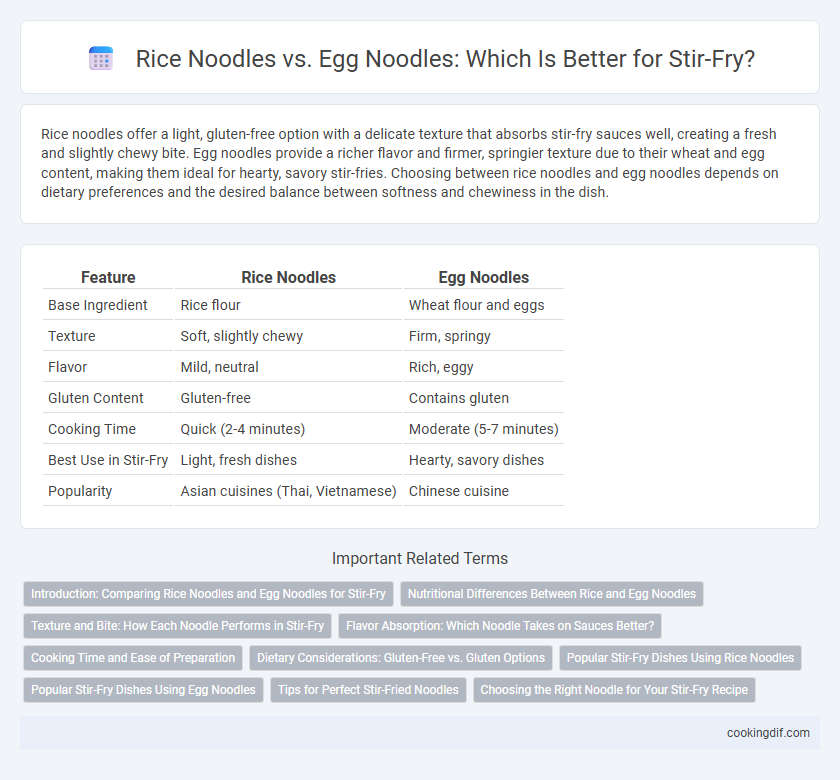Rice noodles offer a light, gluten-free option with a delicate texture that absorbs stir-fry sauces well, creating a fresh and slightly chewy bite. Egg noodles provide a richer flavor and firmer, springier texture due to their wheat and egg content, making them ideal for hearty, savory stir-fries. Choosing between rice noodles and egg noodles depends on dietary preferences and the desired balance between softness and chewiness in the dish.
Table of Comparison
| Feature | Rice Noodles | Egg Noodles |
|---|---|---|
| Base Ingredient | Rice flour | Wheat flour and eggs |
| Texture | Soft, slightly chewy | Firm, springy |
| Flavor | Mild, neutral | Rich, eggy |
| Gluten Content | Gluten-free | Contains gluten |
| Cooking Time | Quick (2-4 minutes) | Moderate (5-7 minutes) |
| Best Use in Stir-Fry | Light, fresh dishes | Hearty, savory dishes |
| Popularity | Asian cuisines (Thai, Vietnamese) | Chinese cuisine |
Introduction: Comparing Rice Noodles and Egg Noodles for Stir-Fry
Rice noodles, made from rice flour and water, are gluten-free and have a light, chewy texture that absorbs stir-fry sauces well; egg noodles contain wheat flour and eggs, offering a richer flavor and firmer bite. Rice noodles cook quickly and are ideal for lighter, delicate stir-fry dishes, while egg noodles withstand longer cooking times and provide a heartier base for robust sauces. The choice between rice noodles and egg noodles depends on dietary preferences, desired texture, and the flavor profile of the stir-fry dish.
Nutritional Differences Between Rice and Egg Noodles
Rice noodles are gluten-free and typically lower in calories and fat compared to egg noodles, making them a preferred choice for those with gluten sensitivities or calorie-conscious diets. Egg noodles contain higher protein and fat due to the inclusion of eggs, contributing to a richer nutrient profile that supports muscle repair and sustained energy. Both noodle types offer essential carbohydrates for energy, but rice noodles provide a lighter, easier-to-digest option, while egg noodles deliver more vitamins like B12 and biotin from the eggs.
Texture and Bite: How Each Noodle Performs in Stir-Fry
Rice noodles offer a chewy, slightly slippery texture that absorbs stir-fry sauces well, creating a light yet satisfying bite. Egg noodles provide a firmer, denser structure with a springy bite that holds up robustly against aggressive tossing and high heat. The choice between rice and egg noodles in stir-fry hinges on desired mouthfeel, with rice noodles favoring softness and egg noodles delivering resilience.
Flavor Absorption: Which Noodle Takes on Sauces Better?
Rice noodles excel at flavor absorption in stir-fry dishes due to their porous texture, allowing them to soak up sauces and seasonings deeply. Egg noodles, with a denser and chewier consistency, tend to hold sauce on their surface rather than fully absorbing it. For recipes that emphasize rich, well-integrated sauce flavors, rice noodles offer superior flavor infusion and a more balanced taste experience.
Cooking Time and Ease of Preparation
Rice noodles cook quickly, typically in 3-5 minutes, requiring only soaking in hot water for ease of preparation, making them ideal for fast stir-fry recipes. Egg noodles generally take longer, around 7-10 minutes to boil, and may require more careful timing to avoid overcooking in stir-fry dishes. Choosing rice noodles enhances convenience and speed, while egg noodles offer a firmer texture but demand more precise cooking control.
Dietary Considerations: Gluten-Free vs. Gluten Options
Rice noodles are naturally gluten-free, making them an ideal choice for individuals with celiac disease or gluten sensitivity seeking a safe stir-fry option. Egg noodles contain wheat flour, which includes gluten, providing a chewier texture and richer flavor but unsuitable for gluten-restricted diets. Selecting between rice and egg noodles depends on dietary needs, with rice noodles offering a lighter, allergy-friendly alternative in gluten-conscious recipes.
Popular Stir-Fry Dishes Using Rice Noodles
Rice noodles are a staple in popular stir-fry dishes like Pad Thai and Drunken Noodles, prized for their light texture and ability to absorb bold flavors. Unlike egg noodles, rice noodles maintain a delicate chewiness without becoming overly dense or greasy, making them ideal for quick-cooking Asian recipes. Their gluten-free nature and compatibility with a variety of sauces and proteins contribute to their widespread use in authentic Southeast Asian stir-fries.
Popular Stir-Fry Dishes Using Egg Noodles
Egg noodles are a staple in popular stir-fry dishes like chow mein and lo mein, prized for their chewy texture and ability to absorb savory sauces. Their wheat-based composition and egg content provide a richer flavor compared to rice noodles, making them ideal for hearty stir-fry combinations with meat, vegetables, and soy sauce-based marinades. Versatility in Asian cuisine allows egg noodles to pair well with a variety of proteins, including chicken, beef, and shrimp, enhancing the overall taste profile of stir-fry dishes.
Tips for Perfect Stir-Fried Noodles
For perfect stir-fried noodles, rice noodles offer a light, chewy texture that absorbs sauce well but require soaking rather than boiling to prevent breakage. Egg noodles provide a sturdier bite and golden color but need careful boiling to avoid overcooking and becoming mushy. Both benefit from quick high-heat cooking and tossing with oil before stir-frying to prevent sticking and ensure even coating.
Choosing the Right Noodle for Your Stir-Fry Recipe
Rice noodles offer a light, gluten-free option with a delicate texture that absorbs stir-fry sauces well, making them ideal for dishes with a fresh, vibrant profile. Egg noodles provide a chewier, richer bite due to their higher protein content and are perfect for hearty stir-fries requiring a robust noodle that holds up to intense flavors and longer cooking times. Selecting between rice and egg noodles depends on dietary preferences, desired texture, and the overall flavor complexity of your stir-fry recipe.
Rice Noodles vs Egg Noodles for stir-fry Infographic

 cookingdif.com
cookingdif.com